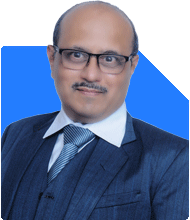45-Year-Old Retiree in India: How to Invest 1 Crore and Secure Retirement with Monthly Expenses of 50k?
Nitin Narkhede | Answer |Ask -Follow
MF, PF Expert - Answered on Nov 07, 2024
As a mentor, Nitin has trained over 1,000 individuals, many of whom have seen remarkable financial transformations.
Nitin holds various certifications including the Association Of Mutual Funds in India (AMFI), the Insurance Regulatory and Development Authority and accreditations from several insurance and mutual fund aggregators.
He is a mechanical engineer from the J T Mahajan College, Jalgaon, with 34 years of experience of working with MNCs like Skoda Auto India, Volkswagen India and ThyssenKrupp Electrical Steel India.... more

I am a 45 year old IT professional with following saving/investment as of now: 30 lacs: EPF 30 lacs: PPF 30 lacs: FD 10 lacs: NPS NOTE: 1. I have monthly expenditure of 50k 2. Additionally, NPS requires 12k monthly investment 3. No liabilities and no loan 4. Staying in own house. Queries: 1. I am planning to retire in next 1-2 years. Pls suggest best way to invest above money. 2. Also, I have gold of worth 25 lacs, so should I keep that with me or instead sell it now and invest money elsewhere?
At 45, retiring at 2 years is 47, with an expense of 50K per month plus 12K per month NPS needs 62K per month. Considering a life expectancy of 77, you need funds for the next 30 years. Not considering medical or any other emergency expenses, you also need 2.25 cr in expenses in the next 30 years. Hence, you can consider rearranging the finances as below.
PPF (?30 Lakhs Total): Continue these as they offer tax-free, secure returns. During retirement, you can withdraw in tranches to maintain liquidity. Keep it as you find financial security; do not touch it, and let it grow.
As you declare retirement at 47, you have EPF (?30 Lakhs Total) and Fixed Deposit (?30 Lakhs). You can withdraw this amount and invest it in Balanced or index MF funds, which offer yearly 12% to 14% average returns. You can also start SWP from this.
NPS is a good retirement investment, but there are many restrictions on premature withdrawals. If you retire at 47, you will not get a withdrawal until age 60 for 60% of the amount, and the balance 40% will be converted to pension after age 60. You can withdraw 60% of the amount from the balance 6 years older for premature withdrawal. If your finances permit, continue investing after retirement.
Gold can be a good hedge against inflation. Gold returns an average of 8 to 10% return on an average. However, if you don't have an emotional attachment or strategic reason to hold it, consider selling and reinvesting in diversified assets like balanced mutual funds or a senior citizen savings scheme for higher returns.
Overall, at 47, you need about 1 cr in your MF for expenses after retirement with 50K PM.
With the amount you have mentioned, you can live a decent life without any frills. My suggestion is that you increase your corpus to fulfill all your life's needs other than your monthly expenses.
Regards,
Nitin Narkhede
Founder & MD, Prosperity Lifestyle Hub https://Nitinnarkhede.com
Free Webinar https://bit.ly/PLH-Webinar
You may like to see similar questions and answers below
Ramalingam Kalirajan |10893 Answers |Ask -Follow
Mutual Funds, Financial Planning Expert - Answered on Jul 15, 2024
Ramalingam Kalirajan |10893 Answers |Ask -Follow
Mutual Funds, Financial Planning Expert - Answered on Oct 14, 2024
Milind Vadjikar | Answer |Ask -Follow
Insurance, Stocks, MF, PF Expert - Answered on Nov 07, 2024
Ramalingam Kalirajan |10893 Answers |Ask -Follow
Mutual Funds, Financial Planning Expert - Answered on May 29, 2025
Ramalingam Kalirajan |10893 Answers |Ask -Follow
Mutual Funds, Financial Planning Expert - Answered on Jul 30, 2025
Ramalingam Kalirajan |10893 Answers |Ask -Follow
Mutual Funds, Financial Planning Expert - Answered on Dec 15, 2025
Ramalingam Kalirajan |10893 Answers |Ask -Follow
Mutual Funds, Financial Planning Expert - Answered on Dec 15, 2025
Radheshyam Zanwar |6746 Answers |Ask -Follow
MHT-CET, IIT-JEE, NEET-UG Expert - Answered on Dec 15, 2025
Ramalingam Kalirajan |10893 Answers |Ask -Follow
Mutual Funds, Financial Planning Expert - Answered on Dec 15, 2025
Ramalingam Kalirajan |10893 Answers |Ask -Follow
Mutual Funds, Financial Planning Expert - Answered on Dec 15, 2025
Ramalingam Kalirajan |10893 Answers |Ask -Follow
Mutual Funds, Financial Planning Expert - Answered on Dec 15, 2025
Samraat Jadhav |2508 Answers |Ask -Follow
Stock Market Expert - Answered on Dec 15, 2025
Ramalingam Kalirajan |10893 Answers |Ask -Follow
Mutual Funds, Financial Planning Expert - Answered on Dec 15, 2025
Reetika Sharma |425 Answers |Ask -Follow
Financial Planner, MF and Insurance Expert - Answered on Dec 15, 2025
Radheshyam Zanwar |6746 Answers |Ask -Follow
MHT-CET, IIT-JEE, NEET-UG Expert - Answered on Dec 15, 2025
























